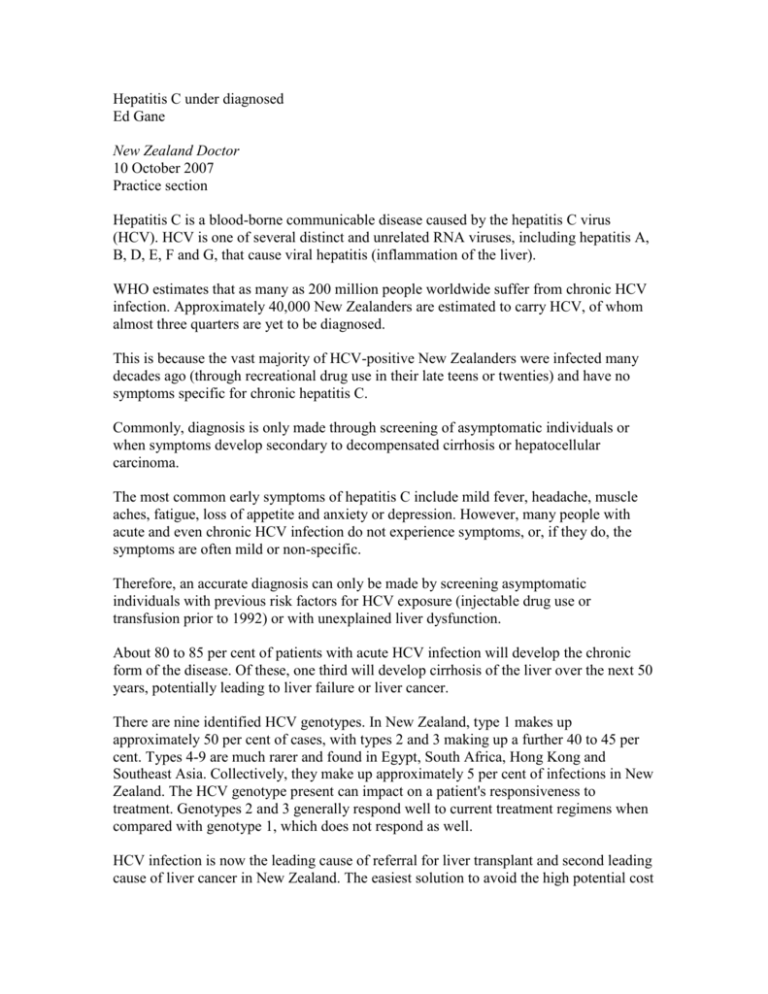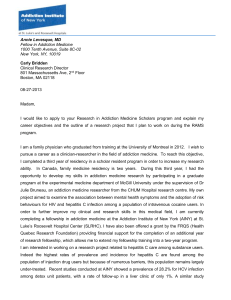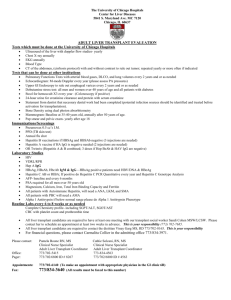Hepatitis C under diagnosed
advertisement

Hepatitis C under diagnosed Ed Gane New Zealand Doctor 10 October 2007 Practice section Hepatitis C is a blood-borne communicable disease caused by the hepatitis C virus (HCV). HCV is one of several distinct and unrelated RNA viruses, including hepatitis A, B, D, E, F and G, that cause viral hepatitis (inflammation of the liver). WHO estimates that as many as 200 million people worldwide suffer from chronic HCV infection. Approximately 40,000 New Zealanders are estimated to carry HCV, of whom almost three quarters are yet to be diagnosed. This is because the vast majority of HCV-positive New Zealanders were infected many decades ago (through recreational drug use in their late teens or twenties) and have no symptoms specific for chronic hepatitis C. Commonly, diagnosis is only made through screening of asymptomatic individuals or when symptoms develop secondary to decompensated cirrhosis or hepatocellular carcinoma. The most common early symptoms of hepatitis C include mild fever, headache, muscle aches, fatigue, loss of appetite and anxiety or depression. However, many people with acute and even chronic HCV infection do not experience symptoms, or, if they do, the symptoms are often mild or non-specific. Therefore, an accurate diagnosis can only be made by screening asymptomatic individuals with previous risk factors for HCV exposure (injectable drug use or transfusion prior to 1992) or with unexplained liver dysfunction. About 80 to 85 per cent of patients with acute HCV infection will develop the chronic form of the disease. Of these, one third will develop cirrhosis of the liver over the next 50 years, potentially leading to liver failure or liver cancer. There are nine identified HCV genotypes. In New Zealand, type 1 makes up approximately 50 per cent of cases, with types 2 and 3 making up a further 40 to 45 per cent. Types 4-9 are much rarer and found in Egypt, South Africa, Hong Kong and Southeast Asia. Collectively, they make up approximately 5 per cent of infections in New Zealand. The HCV genotype present can impact on a patient's responsiveness to treatment. Genotypes 2 and 3 generally respond well to current treatment regimens when compared with genotype 1, which does not respond as well. HCV infection is now the leading cause of referral for liver transplant and second leading cause of liver cancer in New Zealand. The easiest solution to avoid the high potential cost to the health system is for people who are at risk of having contracted the virus to get tested so they can be treated in the early stages of liver disease. Testing will also allow those with the virus to take precautions to avoid spreading the virus further. Unlike the hepatitis B virus (HBV), there is no vaccine for HCV, although it is treatable and potentially curable using a combination of interferon and ribavirin. Recent advances in treatment mean the disease has higher cure rates than was previously achievable. Pegylated interferon is fully funded in New Zealand for the treatment of hepatitis C, delivering sustained viral response rates of 55 per cent in genotype 1 and 80 per cent in genotypes 2 and 3. Advances in the management of hepatitis C are also contributing to improved outcomes for patients, by allowing a greater number of patients to be managed and receive care. Greater GP role in shared-care model Unfortunately, fewer than 5 per cent of New Zealanders with chronic hepatitis C have received antiviral therapy, reflecting underdiagnosis and also real and perceived barriers to treatment. Underdiagnosis and a lack of resources mean that many patients are not being identified early enough, or are missing out on potentially life-saving treatment. Internationally, general practice is taking a leading role in management and treatment of hepatitis C. This is helping to increase the number of patients receiving treatment as well as patient compliance with treatment regimens. Shared-care models have been developed, and are being trialled in a number of countries, including New Zealand. While the responsibility for treatment remains with hospitalbased specialists, there is an increasing trend for general practice to become more involved in overseeing and monitoring hepatitis C patients during the treatment process. This includes monitoring blood tests and helping patients manage symptoms, as well as ongoing harm reduction and nutritional advice. In some cases, primarily in the UK, hospital funded, specialist hepatitis nurses are also delivering treatment in a primary care setting. While shared-care models offers financial savings for the treating hospital, freeing up resources allowing a greater number of patients to be seen, they also offer a more convenient and accessible service for patients, giving them a continuity of care and continuation of the relationship many patients have with their GP. In the UK, this shared-care approach has resulted in increased attendance and compliance with treatment programmes and a greater level of patient involvement with their treatment programme. There are currently a number of shared-care pilot programmes being trialled around New Zealand, including one being run out of Auckland City Hospital. There are also ongoing efforts, centred in Europe but gaining traction worldwide, to increase public awareness of hepatitis C. Monday 1 October was World Hepatitis Awareness Day. Endorsed by WHO (Europe), World Hepatitis Awareness Day aims to encourage anyone who may be at risk of carrying hepatitis C to get a diagnostic blood test, whether or not they experience symptoms, so they can receive any necessary treatment before the liver is irreversibly impaired or before they unwittingly transmit the virus. Ed Gane is associate professor in medicine at the University of Auckland School of Medicine, and hepatologist in charge of the NZ Liver Unit at Auckland City Hospital D ©CMPMedica (NZ)




